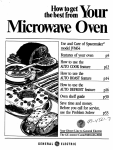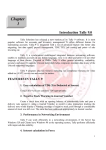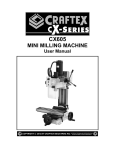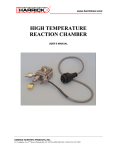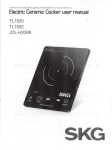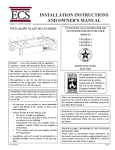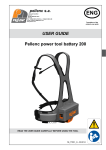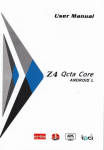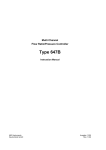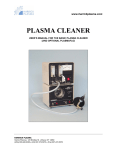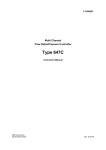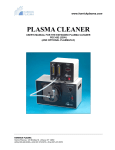Download Praying Mantis Reflection
Transcript
www.harricksci.com THE PRAYING MANTIS™ USER'S MANUAL HARRICK SCIENTIFIC PRODUCTS, INC. 141 Tompkins Ave, 2"d fioor •Pleasantville, NY 10570 • (800) 248-3847 •FAX (914) 747-7209 f:f,l~~~·G-<:>~, TABLE OF CONTENTS "'--~~~~~~~~~~~~~~~~~~~ General Information Unpacking ................................... ...................................... .. ............................... .. ........................ Technical Support... ... .......... ............................. .. .. ....... ......... ............... ... .. .......... ... .. ... ................. Feedback .. ..... .... ... .. ... .. ....... .. ....... .. ... .. .. ..... . ... . .... ..... .. .. .... . ... . ..... ... ...... ..... ...... . ...... ..... ... .............. . 1 1 1 About the Praying Mantis™ 2 Installation and Alignment Open Beam Spectrum ................. ................................................................................................ Getting Ready ........ ................................................................................... ........................ ........... Purge Installation .................... .......................................................... ........................................... Installing the Praying Mantis™ ................... ................................................ ................................. Aligning the Praying Mantis TM ........................ . .................... . .... . ......... . .... . ....... .. ............... ........... Verifying the Throughput ........................................................................................... ........... ....... Specular Reflectance ........................................................... ..... .................................................. 3 3 4 5 6 8 8 Operation Background Spectrum ........................................ .... ........ ......... .................................................... Sample Spectrum ........................................................... ........ ...... .... ......... .................................. 9 9 Ambient Chamber .... ...... .. ..... ......... ..... ..... ................................... ............. ..... .. 10 HVC About the High Temperature Reaction Chamber ........................................................... .. ........... Getting Ready ......... .... ..................................................................... .............. .... .... ...................... Window Installation .................... .................................................................................................. Dome Installation ....................... .................................................................................................. Installing the HVC ... ............................................................ .. ....................................................... Fluid/Electrical Connections ............................ ............................................................. ......... ...... Collecting the Background Spectrum ........................................................................ .. .... ............ Sample Spectrum ........ ......... ..... .. ....... .. ....................................................................................... 12 13 14 15 16 17 18 19 CHC About the Low Temperature Reaction Chamber . . . .. . . .. . . . . . . . . . . . . . . . . . . . . . . . . . . . . . . . . . . .. .. . .. . .. . . . .. . Getting Ready .... .......... ...................................................... ............ ..... .. .... ...... ................ ..... ... ..... Window Installation ................... ...... ......... .. ... ......................................... ... ............... ... .... ... .......... Dome Installation ........................... ..... ...... ................ ..... .... ... ......... .......... ..... ..................... .... ..... . Installing the CHC ... ............... ........................ ............ ............................ .... .................. .... ........ .... Fluid/Electrical Connections ................................................. ..................................... .... ..... ......... Collecting the Background Spectrum . ..... .. ... .. .. ... .... .... ..... .... .. ... .... ..... .. ... ... .......... ... ... .. ... .. .... .... .. Sample Spectrum ....... .................. ........................................................................... :................... DRP-M-04 20 21 22 23 24 27 28 29 TABLE OF CONTENTS Reaction Chamber Maintenance Leak Checking ............ ... .. ................. ...... ..... .. ....... ..... ......... ............. ........... ......... ... ..... ................ Cleaning the Reaction Chambers ............... ..... ....... ....................... ....................... .................. .... Replacing the 0-rings .... ......... .. ... .......... ..... .............. ..... .......................... ......... ......... .... .............. Replacing the Heater ................ ... ................. ...... ................ .. ......................... ... ... ..... ................... Replacing the Thermocouple . .. ..... ...... .... ...... ............. ..... ..... ..... .. ...... ..... ..... ... . ... .. ......... ...... ........ 30 30 31 31 32 Appendix A Mounting the Harrick Rail Plate ................ ....... ..................... .. ... ...... ....... ..... ................. .......... ..... 33 Appendix B Optional and Replacement Parts .................................................................. .. ... ... .. ..... .... ...... ..... 35 f~f,i~l§H~IG-<>~( GENERAL INFORMATION UNPACKING Before Installing the Praying Mantis™ Diffuse Reflection Accessory make sure all the parts on the included check-off list are present. If any parts are missing or damaged, contact Harrick Scientific immediately. TECHNICAL SUPPORT For additional information please contact our Technical Support Center at 800-248-3847 between 9 a.m. and 5 p.m. EST; or e-mail your questions to: [email protected] FEEDBACK Your comments and suggestions are welcome. send them to: Harrick Scientific Products, Inc. PO Box 277 141 Tompkins Ave, 2"d floor Pleasantville, NY 10570 Phone: 800-248-3847; Fax: 914-747-7209 E-mail: [email protected] Web: www.harricksci.com 1of 36 Please ~:f,t~~~·QI(:~' ABOUT THE PRAYING MANTIS™ ---~~~~~~~~~~~~~~~~~--~-- The Praying Mantis™ (DRP) accessory is specifically designed for examining powders by diffuse reflection spectroscopy. The optical design of the Praying Mantis™ incorporates two 6X, 90° off. axis ellipsoid mirrors. The ellipsoids are optically arranged so that their near focal points coincide and they are arranged to discriminate against the collection of specularly reflected radiation. This is achieved by placing the collecting ellipsoid 60° away from the direction of the specularly reflected radiation. The sample Is placed In the common focal point of the two ellipsoid mirrors. The beam Is condensed to a spot less than 2mm in diameter. This allows analysis of very small quantities of sample. A purge fitting and two purge seals are provided if purging is desired. The sample is loaded in to a sample cup. Two cups are included, regular and micro-sampling cups. The sample is typically diluted in a non-absorbing powder. The same non-absorbing powder is used to collect the background spectrum. An optional ambient chamber allows the sample to be loaded in a controlled atmosphere (glove box) and then analyzed without being exposed to room atmosphere. Two reaction chambers are available for use with Praying Mantis™, the high temperature chamber HVC and the low temperature chamber CHC. The reaction chambers enable a reaction gas to be introduced and reacted with the sample so that the reaction can be studied in situ, reaction rates determined and intermediates and reaction products identified. The reaction chambers are enclosed with a dome with three windows, two for the spectrometer radiation to enter and exit the chamber and the third for viewing, illuminating, or irradiating the sample. This enables the use of the reaction chambers for photochemical studies. The standard material for the viewing window is UV quartz and the other two windows are KBr. 2 of 36 INSTALLATION AND ALIGNMENT OPEN BEAM SPECTRUM Prior to installation: • Make sure all sample holders are removed from the sample compartment. • Prior to installation collect an open beam background spectrum (no accessory in the sample compartment). This spectrum should be used later to verify the throughput of the Praying Mantis™. GETTING READY Before installing the Praying Mantis™, familiarize yourself with the accessory and its various components by referring to the drawing of the Praying Mantis rM found below (Figure 1). M5 Cap Purge Line Fitting Window Thumbscrew Purge Sleeve Thumbscrew (2) Foam Purge Seal Purge Door Locking Mechanism Knob Rail Plate Height Adjustment Knob Sample Stage Mounting Screw Figure 1 • Front View of the Praying Mantis™ 3 of 36 INSTALLA T/ON AND ALIGNMENT PURGE INSTALLATION PURGE SLEEVES Loosen the thumbscrews and push the purge sleeves in to retract them (Figure 2). Thumbscrew Purge Collar Foam Purge Seal Figure 2 • Purge Sleeves PURGE LINE For quicker purging or If the spectrometer has windows on the beam ports, connect an additional purge line to the fitting on the Praying Mantis as illustrated in Figure 3. Purge Fitting Figure 3 • Purge Line 4 of 36 INSTALLATION AND ALIGNMENT INSTALLING THE PRAYING MANTIS™ If your spectrometer is equipped with rails: • Install the Praying Mantis 1 M onto the rails. RAIL MOUNTING NOTE: If you received the Harrick rail plate with your Praying Mantis, first mount the supplied rails directly onto the floor of the sample compartment (see Appendix A). • • • • FIXED FLOOR MOUNTING • • Move the Praying Mantis along the rails until the spectrometer focal point is in the center of the attachment. Lock the Praying Mantis in place by tightening the locking mechanism knob. Extend the purge sleeves until they firmly contact the sides of the sample compartment. Lock the purge sleeves in place with the thumbscrews. Install the Praying Manti srM onto the floor of the sample compartment using the base plate provided. Extend the purge sleeves to the walls of the spectrometer and tighten the thumbscrews on the purge collars. 5 of 36 INSTALLATION AND ALIGNMENT ALIGNING THE PRAYING MANTIS™ The Praying Mantis™ has been pre-aligned prior to shipment. Hence It requires only minor adjustments to optimize its performance. • Open the door on the front of the attachment (Figure 1). • Slide the alignment fixture (Figure 4) into the Praying Mantis rM, with the horizontal mirror going in first. In this orientation, the tilted mirror is in the sampling position. • Gently push the alignment fixture in against the stop. Tilted Mirror Figure 4 • Alignment Fixture • • • • • Remove the plastic caps over mirrors M2 and MS. This allows access to the turn and tilt adjustments for these mirrors (Figure 5). Set the spectrometer to measure the "energy" on the detector. Adjust the turn and tilt controls for MS with the supplied 3/32" hex driver until the signal on the detector is maximized. Adjust the height of the alignment fixture with the height adjustment knob to maximize the signal. Adjust the turn and tilt controls for M2. Repeat this sequence until there is no further increase in the signal on the detector. 6 of 36 INSTALLATION AND ALIGNMENT Figure 5 • Interior View of the Praying Mantis™ If using rail mounting: • Loosen the thumbscrews on the purge sleeves. • Unlock the locking mechanism. • Slide the Praying Mantis r M along the rails until the signal is maximized. • Lock the locking mechanism, extend the purge sleeves to the walls of the spectrometer and tighten the thumbscrews on the purge collars. 7 of 36 INS TALLATION AND ALIGNMENT VERIFYING THE THROUGHPUT • Make sure that the specified background spectrum is the previously collected open beam background spectrum. Collect a transmittance spectrum with the Praying Mantis TM in the sample compartment. • NOTE: To maximize the performance of your accessory, it should be tested before first use and at regular intervals thereafter. 90 ..,...-~~~~~~~~~~~~~~ 80 70 ~ 60 ~ w .i J :~ 20 10 O ;--~-.-~----..~~.--~..,....~-.-~.......,.~ 4000 3500 3000 2500 2000 Wavenumber cm- 1 1500 1000 Figure 6 •Praying Mantis™ Throughput SPECULAR REFLECTANCE • • Read the maximum value at 2500 cm-1• The Praying Mantis™ throughput at that wavenumber should be at least 40% and the spectrum should resemble the Praying Mantis™ throughput spectrum shown above. • Slide the alignment fixture (Figure 4) into the Praying Mantis™, with the tilted mirror going in first. In this orientation, the horizontal mirror is in the sampling position. Gently push the alignment fixture In against the . stop. • • The detector now measures the specular reflectance from the mirror. The energy should be near-zero. If it is not less than 10% of the throughput measured earlier, realign with the tilted mirror or contact Harrick Scientific. 8 of 36 f:f,t~~~·Gt<>X' OPERATION "-~~~~~~~~~~~~~~~~~~~~ BACKGROUND SPECTRUM • • • • • • Overfill one of the sampling cups (Figure 7) with the reference material (i.e. KBr). Use the provided sample funnel to fill the microsampling cup. Level off the surface using a flat blade. Open the purge door and slide the sample holder (with the sampling cup going in first) Into the Praying Mantis™, pushing it in against the stop. Close the purge door. Make small adjustments to the height of th e sample using the micrometer to maximize the signal on the detector. Record the background spectrum. Standard Sampling Cup Microsampling Cup Figure 7 • Sampling Cups SAMPLE SPECTRUM • • NOTE: Replace the reference material with th e sample. Record the sample spectrum. If the sample Is a strong absorber it may need to be diluted (approximately 5%) In a nonabsorbent matrix. 9 of 36 f:f,t~~~·Gt<:>*' AMBIENT CHAMBER ----------------------~ USING THE OPTIONAL AMBIENT SAMPLE CHAMBER • • • • • Before using the ambient chamber, verify that the windows, o-ring and groove on the bottom of the dome are clean and free of dust (see page 17). Put the ambient chamber in a glove box or similar enclosed environment. Unscrew the two thumbscrews to remove the dome. Carefully fill the sample cup with the reference. Clean up any spills. Install the dome making sure that the larger orientation slot on the dome engages the orientation pin on the ambient chamber. Dome Orientation Slot Orientation Pin Ambient Chamber Figure 8 ·The Ambient Chamber • • • Remove the sealed ambient chamber from the glove box. Open the purge door and slide the ambient chamber into the Praying Mantis TM, orienting it so that the two notches on the bottom of the ambient chamber go in first. Close the purge door. 10 of 36 AMBIENT CHAMBER • • • • Make small adjustments to the height of the sample using the micrometer to maximize the signal on the detector. Record the background spectrum. Replace the reference material with the sample. Record the sample spectrum. 11 of 36 HVC ABOUT THE HIGH TEMPERATURE REACTION CHAMBER (HVC) The HVC is designed for operation up to 910°C under vacuum (the lifetime of the heater is significantly reduced at temperatures above 450°C). The pressure range is from high vacuum to pressures up to 3.44MPa or 25.8 ktorr (the high pressure dome is required for pressures above 133 µPa or 1 ktorr). At higher pressures, the maximum operating temperature may be lower HVC is made of chemically resistant 316 stainless steel. Within the chamber Is a temperaturecontrolled sample stage with integral sample cup. This stage incorporates a cartridge heater and a thermocouple. It Is thermally isolated from the outer chamber wall. A water-cooling jacket controls the temperature of the outer surface of the chamber and windows during high or low temperature operation. The reaction chamber has three gas ports for evacuating, pressurizing or flowing gas through the sample. These ports are equipped with 1/4" VCO fittings. The vacuum port leads directly under the sample cup; the two gas por1s lead into the sides of the chamber. The chamber is enclosed with a dome with three windows. two for the spectrometer radiation to enter and exit the chamber and the third for viewing, illuminating, or irradiating the sample. This enables the use of the reaction chambers for photochemical studies. The standard material for the observation window is UV quartz and KBr for the other two windows. CAUTION: Parts for the high pressure and low pressure domes should not be exchanged. The high pressure domes undergo high pressure testing and are guaranteed to worl< under the rated pressure. 12 of 36 HVC GETTING READY Before installing the High Temperature Reaction Chamber (HVC) familiarize yourself with it by referring to the drawing of the HVC found below (Figure 9). HVC Dome Gas Inlet/Outlet Gas Outlet Mounting pins (2) Inlet/Outlet Heater Connector Heater Access Hole Figure 9 •The High Temperature Reaction Chamber HVC 13 of 36 HVC WINDOW INSTALLATION If the windows are not already installed or need to be cleaned or changed follow the steps below (Figure 10). NOTE: The observation window is the window that is located between the two semicircular indentations on the rim of the dome. • Insert an o-ring in one of the window ports. • Hold the retaining ring upside-down and place a PTFE washer inside. • Then carefully place a window on top of the PTFE washer. • Hold the retaining ring so that it continues to retain the window and thread it into the window port. • Tighten to secure the window in place using the tool provided for tightening and loosening the retaining rings. • Repeat these steps until all three windows are installed. NOTE: Be careful not to touch the windows during Installation. Retaining Ring I (J' Window Dome PTFE Washer Semicircular Indentation (2) Figure 10 • Installing the HVC Dome Windows 14 of 36 HVC DOME INSTALLATION Although it is not necessary to install the dome until later, it is recommended to become familiar with the procedure before proceeding to the next step. • Prior to installation of the dome make sure that the o-ring and groove on the bottom of the dome are clean and free of dust. • Retract the retaining plates on the HVC as far as possible . • Install the dome making sure that the orientation slot on the dome engages the orientation pin on the HVC (Figure 11 ). • Slide the retaining plates all the way over the rim of the dome. • Tighten tn1:: ;etaining plate screws to secure the dome. Orientation slot Relaining Plate S"e~ O•lentalion pin ~ I Figure 11 • Installing the HVC Dome 15 of 36 HVC INSTALLING THE HVC Before installing the HVC in the Praying Mantis™, make sure that the Praying Mantis™ is aligned in the spectrometer. • Unscrew the thumbscrew on the top plate of the Praying Mantis™ (Figure 1). • Carefully swing the top plate of the Praying Mantis™ out of the way. • Grasp the sample stage (Figure 12) and unscrew its mounting screw. • Slide the sample stage slightly to the left to dislocate Its mounting pins. • Remove the sample stage. • Locate the mounting pins on the side of the HVC (Figure 9) in the pin holes where the sample stage was located. • Reinstall and tighten the sample stage mounting screw. Mounting Screw Sample stage Mounting Pins (2) Figure 12 •Installing the HVC 16 of 36 HVC Thermocouple Figure 13 •The HVC Installed FLUID I ELECTRICAL CONNECTIONS • • • • • If temperature control is desired, connect the thermocouple and the heater (Figure 13) to a suitable temperature controller. If the HVC is to be operated at temperatures above 100°C, use 1/4" tubing to connect the two cooling ports (see Figure 13) to a water inlet/outlet or a coolant circulator. If vacuum is desired, connect the gas outlet (1/4" VCO fitting, see Figure 13) to a vacuum pump or other source of vacuum using 3/8" l.D. vacuum tubing. Seal off the two gas inleUoutlet ports. If reaction or process gas/es are to be passed through the sample, connect the gas inleUout ports (1 /4" VCO fitting, see Figure 13) as needed to the gas source/s. Connect the gas outlet and seal off any unused gas ports. If reaction or process gas/es are to be passed over the sample, seal off the gas outlet. Connect one of the gas inlet/outlet ports to the gas source and the other as the outlet. 17 of 36 HVC COLLECTING THE BACKGROUND SPECTRUM • • • • • • • • • Place a sample screen into the sample cup and locate the plastic overflow tray over the sample cup (Figure 14). Fill the sample cup with the reference material using the provided packing tool. Draw the straightedge across the top of the cup to level off the surface. Carefully remove the overflow tray. Install the dome on the HVC (see page 15). Swing the Praying Mantis rM cover back into place and tighten the thumbscrew. Set the temperature and pressure to desired operating conditions. Set the spectrometer to measure the "energy" on the detector. Adjust the micrometer (Figure 1) to maximize the signal on the detector. Collect the background spectrum. Overflow Tray Sample Cup Figure 14 • Fiiiing the Cup 18 of 36 HVC SAMPLE SPECTRUM • • • • • • • • • • • Restore the reference material to ambient conditions. Remove the dome. Empty the sample cup. This can be done by vacuuming out the reference sample or by removing the HVC from the Praying Mantis™ and dumping out the material. If needed, clean the sample cup. Fill the sample cup with the sample (follow procedure in the alignment section). Install the dome. Install the HVC into the Praying Mantis™ if it was removed to empty the sample cup. Swing the top plate back into place and tighten the thumbscrew (Figure 1). Restore the desired sampling conditions. Collect the sample spectrum. Empty the sample cup and clean it before running the next sample. 19 of 36 f:f,t~~F-!•G-<>X' CHC '-~~~~~~~~~~~~~~~~~~~~ ABOUT THE LOW TEMPERATURE REACTION CHAMBER (CHC) The CHC is designed for operation from -150°C up to 600°C under vacuum. The pressure range is from high vacuum (133 ~lPa or 10·5 torr) to pressures up to 304kPa or 2.3 ktorr (for pressures above 133 kPa or 1 ktorr use either the high pressure dome or use Si0 2 or ZnSe windows). At higher pressures, the maximum operating temperature may be lower. The CHC is made of chemically resistant 316 stainless steel. Within the chamber Is a temperature-controlled sample stage with an Integral sample cup. This stage incorporates a cartridge heater and two thermocouples, one in the sampling stage and one in the sample cup. The sample stage is thermally isolated from the outer chamber wall. A water-cooling jacket controls the temperature of the outer surface of the chamber and windows during high or low temperature operation. The chamber has three gas ports for evacuating, pressurizing or flowing gas through the sample. These ports are equipped with 1/4" VCO fittings. One of the ports leads directly under the sample cup, the other two lead into the sides of the chamber. The chamber is enclosed with a dome with three windows, two for the spectrometer radiation to enter and exit the chamber and the third for viewing, illuminating, or irradiating the sample. This enables the use of the reaction chambers for photochemical studies. The standard material for the observation window is UV quartz and KBr for the other two windows. ~ CAUTION: Parts for the high pressure and low pressure domes should not be exchanged. The high pressure domes undergo high pressure testing and are guaranteed to work under the rated pressure. 20 of 36 CHC Before installing the Low Temperature Reaction Chamber (CHC) familiarize yourself with it by referring to the drawing of the CHC found below (Figure 15). GETTING READY -Dewar Elevation Adjustment Micrometer CHC Dome Gas Outlet Heater Connector Thumbscrew Hole Cooling Port (2) Figure 15 • The Low Temperature Reaction Chamber CHC 21 of 36 CHC WINDOW INSTALLATION If the windows are not already installed or need to be cleaned or changed follow the steps below (Figure 16). NOTE: The observation window is the window that Is located between the two semicircular indentations on the rim of the dome. • Insert an o-ring in one of the window ports. • Hold the retaining ring upside-down and place a PTFE washer Inside. • Then carefully place a window on top of the PTFE washer. • Hold the retaining ring so that it continues to retain the window and thread it into the window port. • Tighten to secure the window in place using the tool provided for tightening and loosening the retaining rings. • Repeat these steps until all three windows are installed. NOTE: Be careful not to touch the windows during installation. Retaining Ring Window Dome PTFE Washer 0-Ring Semicircular Indentation (2) Figure 16 • Installing the CHC Dome Windows 22 of 36 CHC DOME INSTALLATION Although it is not necessary to install the dome until later, It is recommended to become familiar with the procedure before proceeding to the next step. • Prior to installation of the dome make sure that the o-rlng and groove on the bottom of the dome are clean and free of dust. • Retract the retaining plates on the CHC as far as possible. • Install the dome making sure that the orientation slot on the dome engages the orientation pin on the CHC (Figure 17). • Slide the retaining plates all the way over the rim of the dome. • Tighten the retaining plate screws to secure the dome. Orientation slot Retaining Plate (2) Figure 17 • Installing the CHC Dome 23 of 36 CHC INSTALLING THE CHC Before installing the CHC in the Praying Mantis TM, the Praying Mantis TM should have been aligned In the spectrometer. • Unscrew the thumbscrew on the top plate of the Praying Mantis TM . • Carefully swing the top plate of the Praying Mantis TM out of the way. • Grasp the sample stage and unscrew its mounting screw. • Slide the sample stage slightly to the left to disengage its mounting pins. • Remove the sample stage. For spectrometers with a low working height (2" or less), some additional assembly is required to mount the CHC on the Praying Mantis. This includes the Varian FTIR spectrometers with serial numbers starting with DRPDl4, DRPDIS, DRPDl6, DRPDl7 and DRPDl8. • Lift the accessory out of the sample compartment and rest it on its back. • Loosen the two setscrews that secure the knob and slide the knob off its rod (see Figure 18). Knob Setscrews (2) // Figure 18 •The Camlock Plate 24 of 36 CHC • • • Slide the locking adapter over the rod, as shown in Figure 19. Tighten th e two setscrews to secure the locking adapter. Mount the CHC mounting plate on the Praying Mantis™ body, as described on the next page. Be sure to carefully slide the mounting plate between the bottom plate of the Praying Mantis and the camlock plate. CHC Mounting Plate Locki ng Adapter Setscrews (2) Figure 19 •Installing the Locking Adapter 25 of 36 CHC • • Slide the CHC mounting plate (Figure 20) under the Praying Mantis TM body locating the CHC mounting plate pin in the hole In the bottom of the Praying Mantis TM . Use the two pan head screws provided to secure the mounting plate in place. Thumbscrew Hole CHC Locating Pin Hole Praying Mantis Figure 20 • Installing the CHC Mounting Plate (Top View) • • Mount the CHC by guiding the locating pin which is directly under the CHC body into the locating hole In the DRP base. Fasten the thumbscrew (Figure 21) to secure the CHC to the CHC mounting plate. Dewar Heater Thermocouple CHC Mounting Plate Gas lnlel/Outlet (2) Thumbscrew Figure 21 • The CHC installed 26 of 36 CHC FLUID I ELECTRICAL CONNECTIONS • • • • • If temperature control is desired, connect the thermocouple and the heater (Figure 21) to a suitable temperature controller. If the CHC is to be operated at temperatures above 1oo•c or below o•c, use 1/4" tubing to connect the two cooling ports (see Figure 22) to a water inleUoutlet or a coolant circu lator. If vacuum is desired, connect the gas outlet (1/4" VCO fitting , see Figure 22) to a vacuum pump or other source of vacuum using 3/8" l.D. vacuum tubing. Seal off the two gas inleUoutlet ports. If reaction or process gas/es are to be passed through the sample, connect the gas inleUout ports (1/4" VCO fitting, see Figure 22) as needed to the gas source/s. Connect the gas outlet and seal off any unused gas ports. If reaction or process gas/es are to be passed over the sample, seal off the gas outlet. Connect one of the gas inleUoutlet ports to the gas source and the other as the outlet. Gas lnleVOutlet Cooling Ports / Gas lnleVOutlet Gas Outlet Figure 22 •The CHC Installed 27 of 36 CHC COLLECTING THE BACKGROUND SPECTRUM • • • • • • • • • • Place a sample screen into the sample cup and locate the plastic overflow tray over the sample cup (Figure 21). Fill the sample cup with the reference material using the provided packing tool. Draw the straightedge across the top of the cup to level off the surface. Carefully remove the overflow tray. Install the dome. Swing the Praying Mantis TM cover back into place and tighten the thumbscrew (Figure 1). Fiii the Dewar with liquid nitrogen or other coolant. Set the temperature and pressure to desired operating conditions. Set the spectrometer to measure the "energy" on the detector. Adjust the elevation adjustment microm eter on the CHC (Figure 15) to maximize the signal on the detector. Collect the background spectrum . 28 of 36 CHC Overflow Tray Sample Cup Figure 23 • Filling the Cup SAMPLE SPECTRUM • • • • • • • • • • • Restore the reference material to ambient conditions. Remove the dome. Empty the sample cup. This can be done by vacuuming out the reference sample or by removing the CHC from the Praying Mantis rt.1 and dumping out the material. If needed clean the sample cup. Fill the sample cup with the sample (follow procedure in the alignment section). Install the dome (see page 23). Install the CHC into the Praying Mantis™ if it was removed to empty the sample cup. Swing the top plate back into place and tighten the thumbscrew (Figure 1). Restore the desired sampling conditions. Collect the sample spectrum. Empty the sample cup and clean it before running the next sample. 29 of 36 f:f,t~~~ltjt(>x ~ REACTION CHAMBER MAINTENANCE LEAK CHECKING The Reaction Chambers have been carefully checked for leaks before shipment. However, each time the Reaction Chambers are disassembled and reassembled, leaks may develop due to improper setting of the o-rings. If leaks occur, carefully inspect all o-rings and sealing surfaces for damage and contamination. Small leaks can be pinpointed using a Helium Leak Detector. Contact Harrick Scientific Products, Inc. for advice and/or repair information. CLEANING THE REACTION CHAMBERS To thoroughly clean the reaction chambers follow the procedure below. To clean the HVC: • Vacuum out the sample or remove the HVC from the Praying Mantis™, remove the dome, turn the HVC upside-down and dump out the sample. • Use solvent to clean off the remaining sample. • Unscrew the eight screws that secure the bottom cover of the HVC. • Remove the bottom cover to reveal three access holes. • Gingerly wipe or blow clean air through these holes to clean the interior of the HVC. • When the interior is clean, make sure the a-rings on the bottom plate are clean and free of dirt. • Re-install the bottom cover. To clean the CHC: • Vacuum out the sample or remove the CHC from the Praying Mantis TM, remove the dome, turn the CHC upside-down and dump ou t the sample. • Use solvent to clean off the remaining sample. • Unscrew the four screws that secure the bottom cover of the CHC. • Remove the bottom cover to reveal the access hole. • Gingerly wipe or blow clean air through the hole to clean the interior of the CHC. • When the interior is clean, make sure the o-ring on the bottom plate is clean and free of dirt. • Re-install the bottom cover. 30 of 36 REACTION CHAMBER MAINTENANCE REPLACING THE 0 -RINGS The a-rings used by the Reaction Chambers should be replaced periodically. The Reaction Chambers have o-rings for sealing the windows, o-rings for sealing the access holes, a-rings on the fittings, and an o-ring to seal the dome to the Reaction Chamber. REPLACING THE HEATER To replace the HVC heater: • Remove the HVC from the Praying Mantis™ . • Loosen the screw on the side of the HVC that anchors the heater wire to the HVC. • Remove the two screws at the back of the HVC that clamp down the heater and thermocouple wires. • Push a small, blunt object through the heater access hole (Figure 9) at the front of the HVC. • Slide the heater out the back of the unit. • To install a new heater, coat the heater with MgO powder (Maalox™ or the equivalent). • Slide it into the HVC until it hits the stop. • Make sure that the heater is inserted completely into the body before re-securing the wire. To replace the CHC heater: • Remove the CHC from the Praying Mantis TM . • Push a small, blunt object through the heater access hole (Figure 15) at the opposite side of the heating wires. • Slide the heater out the other side of the unit. • To install a new heater, coat the heater with MgO powder (Maalox™ or equivalent antacid). • Slide It Into the CHC until it hits the stop. • Make sure that the heater is inserted completely into the body before re-securing the wire. 31 of 36 REACTION CHAMBER MAINTENANCE REPLACING THE THERMOCOUPLE To replace the HVC thermocouple: • Remove the HVC from the Praying Mantis TM. • Loosen the screw on the side of the HVC that anchors the thermocouple wire to the HVC. • Remove the two screws at the back of the HVC that clamp down the heater and thermocouple wires. • Gently pull out the thermocouple. • Slide the new thermocouple into the HVC until it hits the stop. • Make sure that the thermocouple is inserted completely into the body before re-securing the wire. To replace the CHC thermocouple: • Remove the CHC from the Praying Mantis™. • Gently pull out the thermocouple. • Slide the new thermocouple into the CHC until it hits the stop. • Make sure that the thermocouple is inserted completely into the body before re-securing the wire. 32 of 36 APPENDIX A To install the supplied rail plate onto the floor of the sample compartment of your spectrometer: • Remove any existing sample holders from the floor of the spectrometer. Install the rail plate in the orientation indicated in Figure 24. See Table 1 on the next page for the appropriate screws/holes for your spectrometer. MOUNTING THE HARRICK RAIL PLATE Mating Plate Harrick Rail Plate BACK @ 8 D c @ 0 ) ) @ A A @ 0 c D 8 @ FRONT Figure 24 • Screw and Pin Positions for Rail Plate 33 of 36 APPENDIX A FTIR SPECTROMETERS HOLES VARIAN or D IGILAB (All Models) A MATTSON (Polaris, Galaxy, RS Infinity, Genesis, Satellite) B PERKIN ELMER (Spectrum 1) c THERMO-NICOLET (Nexus, Avatar, Magna, Impact) D Table 1 • Screw and Pin Positions for Rall Plate 34 of 36 f~bt~~Flj1tjl(:S{ APPEND/XS '--·~~~~~~~~~~~~~~~~~~~ OPTIONAL AND REPLACEMENT PARTS OPTIONAL PARTS (Praying Mantis™) Ambient Sample Chamber ................................................................................... High Temperature Reaction Chamber, 24V (FTIR) ............................................... Low Temperature Reaction Chamber, 24V (FTIR) .............................................. High Temperature Reaction Chamber, 24V (UV-Vis) ...................... .. .. .. ............... Low Temperature Reaction Chamber, 24V (UV-Vis) ............................................ Spectroscopic Grade KBR Powder ...................................................................... DRP-ASC HVC-DRP-4 CHC-CHA-3 HVC-VUV-4 CHC-VUV-3 KBR-100 OPTIONAL PARTS (Reaction Chambers) Temperature Controller, 110V ................................................................................ ATC-024-1 Temperature Controller, 220V ................................................................................ ATC-024-2 Vacuum Pump, 110V .... ........ ............................................................... ................... VPE-001 Vacuum Pump, 220V .. .. .. ..................................................................... ..... .. ............ VPE-002 UV Quartz Window for the Vacuum/Low Pressure Domes .......... ..... .. .. .. ............... WAD-U23 Si Window for the Vacuum/Low Pressure Domes ........... .. ..................................... WED-U23 CaF2 Window for the Vacuum/Low Pressure Domes ............................................ WFD-U23 ZnS Window for the Vacuum/Low Pressure Domes .............................................. WID-U23 ZnSe Window for the Vacuum/Low Pressure Domes ............................................ WMD-U23 KBr Window for the Vacuum/Low Pressure Domes ............................................... WPD-U23 0 -Ring (#23) for the Dome, Kalrez ....................................... ................................... ORK-023 0 -Ring (#13) for Windows of the Dome, Kalrez ............ .. ....................................... ORK-01 3 0 -Ring (#10) for the VCO Fittings, Kalrez .............................................................. ORK-010 HVC Reaction Chambers Only High Pressure Dome, ZnS Windows ................................................................... High Pressure Dome, ZnSe Windows ................................................................. High Pressure Dome. UV Quartz Windows ........................................................ ZnS Window for the High Pressure Dome .................... ....................................... ZnSe Window for the High Pressure Dome ........................................................ UV Quartz Window for the High Pressure Dome ........ ........................................ 0 -Ring (#16) for the Bottom Cover, Kalrez .... ............. ............ .. ........ .................. HVC-DWl-3 HVC-DWM-3 HVC-DWA-3 WID-U43 WMD-U43 WAD-U43 ORK-016 CHG-CHA Reaction Chambers Only 0 -Ring (#001) for Thermocouple Fitting, Kalrez ................................................. ORK-001 0 -Ring (#26) for the Bottom Cover, Kalrez ....................................... .................. ORK-026 0 -Ring (#19) for the Dewar, Kalrez ..................................................................... ORK-019 35 of 36 APPENDIXB REPLACEMENT PARTS (Praying Mantis™) Alignment Fixture ..... ...... .. .... .. ....... .. ... .... ..... ......... .... ......... ... ..... ..... . .... .. ... ... .. ... .. .... .. Sampling Accessory Kit .. ......... ................................................................................ Micro-sampling Cup .. .................... .............. .......... .... ......... .. .......... .. .... ..... ..... .......... Sampling Cup ............................................. ................................................ ............. DRP-ALN ORA-SAP DRP-SAP DRP-S10 REPLACEMENT PARTS (Reaction Chambers) Packing Tool ...... ........................................................................... ........ .................. Screen Set, two each of three mesh size ............................................................... K-Type Thermocouple .................................................................... ........................ Flex Mounting Plug - Male ............................................. .. .............. ........................ UV Quartz Window for the Vacuum/Low Pressure Domes .......... .......................... KBr Window for the Vacuum/Low Pressure Domes ... .. .... ............................... ....... 0 -Ring (#23) for the Dome, Vlton .................... ....................................................... 0 -Ring (#13) for Windows of the Dome, Viton ....................................................... 0 -Ring (#10) for the VCO Fittings, Viton ...................... .... ................... ................... 116-836 116-439 008-144 008-266 WAD-U23 WPD-U23 ORV-023 ORV-013 ORV-010 HVC Reaction Chambers Only UV Quartz Window for the High Pressure Dome ................................................ 1.00"x0.25" Cartridge Heater, 100W, 24V ................. .......................... ................ 24V Heater Assembly ......... ............ ......... ...................... ...................................... 0 -Ring (#16) for the Bottom Cover, Viton ........................................................... Overflow tray ............... .. .. .. ................................................................. .. ..... .......... WAD-U43 HTRS-26 HVC-HT4 ORV-016 116-835 CHG-CHA Reaction Chambers Only 24V Heater Assembly .................... ...................................................................... 1.00"x0.25" Cartridge Heater. 75W, 24V ........................................... .................. 0 -Ring (#001) for Thermocouple Fitting, Viton ............................... .................... 0 -Ring (#26) for the Bottom Cover, Viton .... ..... .................................................. 0-Ring (#19) for the Dewar, Viton ........ ............. .................................................. Overflow tray ........................................ ............................................................... HVC-HTR HTRS-16 ORV-001 ORV-026 ORV-019 116-854 36 of 36 f:f,t~~~·tjl(>~' Manual Part No. DRP-M-04 "-~~~~~~~~~~~~~~~~~- ©2009 Harrick Scientific Products, Inc. 80 70 60 Q) ..,----__.-- ,,....,...,.,,., .~ --- -· 50 0 c: «l I~ (/) c: ca .... 40 I- ~ 0 30 20 10 0 40~0~ 0~~~~~~~~~~~~~~~~~~~~~~~~~~~~~~~~~~~~_..!, 3000 2000 Wavenumbers (cm-1) Date: Wed Feb 24 12:32:26 2010 (GMlWed Feb 24 12:32:17 2010 (GMT-05:00) Scans:8 Resolution: 8.000 1000 DRPNl85999011001












































